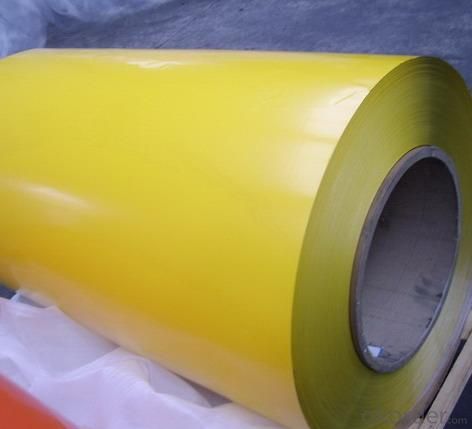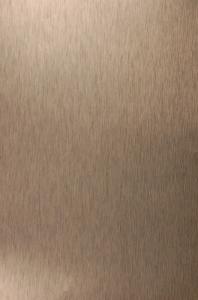Coated Aluminium Sheets According to RAL NO. from China
- Loading Port:
- Shanghai
- Payment Terms:
- TT or LC
- Min Order Qty:
- 5 m²
- Supply Capability:
- 9000 m²/month
OKorder Service Pledge
OKorder Financial Service
You Might Also Like
CNBM colour coated aluminium sheet
Colored aluminum foil rolls are widely applied to aluminum ceiling, roofing, fireproof roller shutter, doors, wall panel , facade cladding, etc.
1. Specification for coated aluminum coils
01)Material: aluminum alloy A1100, A3003, A3005, A3105
02)Aluminum thickness:0.20-1.20mm
03)Max coil width: 1600mm(standard 12 40mm)
04)Coil's standard diameter:1200mm, Interior diameter: 405mm,505mm, etc.
05) weight: 0.5-3.0T/coil or by buyer's option
06) Surface treatment: PE or PVDF coating
07) Color: solid, metallic, glossy, matte, wooden grain, marble stone,etc.
08) Dried and baked: oven baked at 450 degree F
09) Coating thickness: PVDF-25 micron, PE-18 micron
10) Coating hardness: (pencil hardness) HB
11) Coating adhesive: no lower than first grade
12) Impact resistance: no cracking and peeling(50kg/cm, ASTMD-2794:1993)
13)Flexibility(T-bend):2T or by your option
14) MEK resistance: more than 100
15)Outer packing: wooden plate, covering with craft paper and film, Eye to Sky or wall to Sky packing.

2. Applications
Interior applications:wall cladding, ceilings, bathrooms, kitchens and balconies, shutters, doors...
Exterior applications: wall cladding, facades, roofing, canopies, tunnels,column covers , renovations...
Advertisement and market applications: display platforms, signboards, fascia, shop fronts...

Packaging & Delivery
| Packaging Details: | Covering the coil with craft paper and films, and packed with wooden pallets. |
| Delivery Detail: | 10-15 days after getting deposit |

- Q:Are aluminum sheets suitable for roofing?
- Indeed, aluminum sheets prove to be a fitting choice for roofing purposes. Renowned for its lightweight nature, durability, and corrosion resistance, aluminum stands out as a favored material in the roofing industry. Moreover, its non-combustible properties render it a safer alternative. The ease of installation and maintenance further add to its appeal, as do its ability to withstand adverse weather conditions like heavy rain, snow, and wind. Notably, aluminum also earns accolades as an environmentally conscious option, boasting 100% recyclability. In summary, aluminum sheets offer a trustworthy and enduring roofing solution for both residential and commercial edifices.
- Q:What are the typical uses or applications for 101 aluminum sheets?
- 101 aluminum sheets are commonly used in a variety of applications such as roofing, siding, gutters, and general construction due to their excellent corrosion resistance, high formability, and durability. They are also utilized in the automotive industry for body panels, trims, and interior components. Additionally, 101 aluminum sheets are often used for packaging, electrical enclosures, and kitchen equipment due to their lightweight nature and ability to withstand various environmental conditions.
- Q:Can aluminum sheets be used for food processing conveyors?
- Indeed, food processing conveyors can make use of aluminum sheets. The numerous desirable properties of aluminum render it a favored option for food processing equipment. Its lightweight nature, resistance to corrosion, and exceptional thermal conductivity make aluminum sheets extraordinarily well-suited for the task of facilitating the transportation of food products within the demanding environment of food production. Furthermore, aluminum's ease of cleaning and maintenance further bolsters its appeal as a hygienic choice for food processing applications.
- Q:why is aluminium used instead of copper for high voltage electrical cables????
- All of the earlier answers are correct and the first one is very good but nobody mentioned the fact that aluminium does not have much tensile strength, and that as a result of this, some high voltage aluminium cables have a steel cable in the centre to give them the required tensile strength. Aluminium bus-bars are very popular in low voltage work because they do not need to be flexible or possess much tensile strength but yet provide the benefits of being light and cheap.
- Q:Can aluminum sheet be used for electrical wiring?
- No, aluminum sheet cannot be used for electrical wiring. Aluminum sheet is primarily used for structural and decorative purposes due to its lightweight and corrosion-resistant properties. However, aluminum wire, which has different characteristics and is specifically manufactured for electrical applications, can be used for electrical wiring. Aluminum wire was commonly used in the past, but due to concerns about its conductivity, durability, and potential fire hazards, it has been largely replaced by copper wire in residential and commercial electrical installations. Copper wire is preferred for its superior conductivity and lower risk of developing loose connections or overheating.
- Q:Can aluminum sheets be coated with other materials?
- Aluminum sheets have the capability to undergo a process called aluminum sheet coating or aluminum sheet finishing, wherein they are coated with different materials. This coating process serves several purposes, such as enhancing their appearance, protecting against corrosion, increasing durability, and providing insulation. Painting, anodizing, laminating, and powder coating are among the various methods available to coat aluminum sheets. Each method offers unique advantages and is selected based on the desired outcome and intended usage of the coated aluminum sheet. Coating aluminum sheets with other materials allows for customization, versatility, and enhanced functionality in a wide range of industries, including construction, automotive, aerospace, and consumer goods.
- Q:Are aluminum sheets suitable for electrical transformers?
- Yes, aluminum sheets are suitable for electrical transformers. Aluminum is a highly conductive material that offers several advantages for use in transformers. Firstly, it has a lower electrical resistance compared to other materials like copper, which means it can efficiently transfer electrical energy. This results in lower energy losses and better overall performance. Additionally, aluminum is lightweight, making it easier to handle and install. It is also more cost-effective than copper, making it a preferred choice for large-scale transformer applications. Overall, aluminum sheets provide a reliable and efficient solution for electrical transformers.
- Q:When Aluminium nitrate is heated , i got yellow amorphous solid which did not not melt on further heating. What compound is that?
- Aluminium nitrate follows the rules for metal nitrate decomposition. Group I nitrate Na K etc --- nitrite + oxygen Other metal nitrate --- Metal Oxide + nitrogen dioxide + oxygen So your final product is aluminium oxide.
- Q:I can't seem to find what uses or contains Aluminum Nitride. Help!
- Don't know where you looked, but this came up with very basic web search. Metallization methods are available to allow Aluminium nitride to be used in electronics applications similar to those of alumina and beryllium oxide. Among the applications of Aluminium nitride are opto-electronics, dielectric layers in optical storage media, electronic substrates, chip carriers where high thermal conductivity is essential, military applications, as a crucible to grow crystals of gallium arsenide, steel and semiconductor manufacturing. Epitaxially grown thin film crystalline aluminium nitride is also used for surface acoustic wave sensors (SAW's) deposited on silicon wafers because of the Aluminium nitride's piezoelectric properties. One application is an RF filter used in mobile phones called a thin film bulk acoustic resonator (FBAR). This is a MEMS device that uses aluminium nitride sandwiched between two metal layers.
- Q:Are aluminum sheets suitable for decorative lighting fixtures?
- Yes, aluminum sheets are suitable for decorative lighting fixtures.
1. Manufacturer Overview |
|
|---|---|
| Location | |
| Year Established | |
| Annual Output Value | |
| Main Markets | |
| Company Certifications | |
2. Manufacturer Certificates |
|
|---|---|
| a) Certification Name | |
| Range | |
| Reference | |
| Validity Period | |
3. Manufacturer Capability |
|
|---|---|
| a)Trade Capacity | |
| Nearest Port | |
| Export Percentage | |
| No.of Employees in Trade Department | |
| Language Spoken: | |
| b)Factory Information | |
| Factory Size: | |
| No. of Production Lines | |
| Contract Manufacturing | |
| Product Price Range | |
Send your message to us
Coated Aluminium Sheets According to RAL NO. from China
- Loading Port:
- Shanghai
- Payment Terms:
- TT or LC
- Min Order Qty:
- 5 m²
- Supply Capability:
- 9000 m²/month
OKorder Service Pledge
OKorder Financial Service
Similar products
New products
Hot products
Related keywords






























